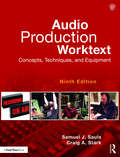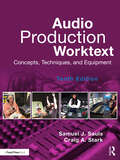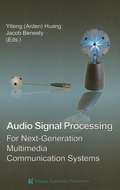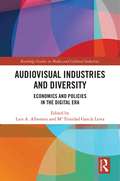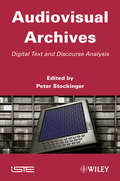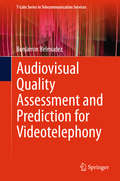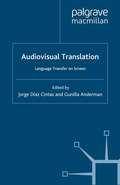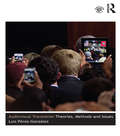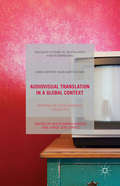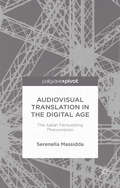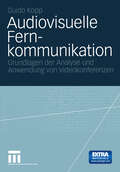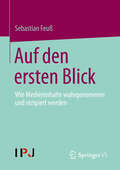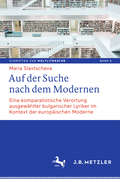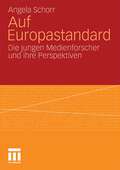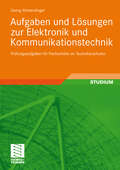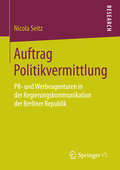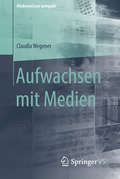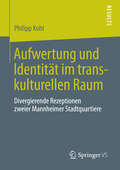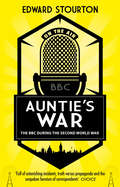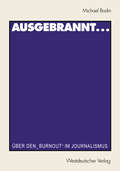- Table View
- List View
Audio Production Worktext: Concepts, Techniques, and Equipment
by Samuel J. Sauls Craig A. StarkAudio Production Worktext, 9th Edition provides readers the best introduction to audio and radio production. It shows how to navigate modern radio production studios and utilize the latest equipment and software. The 9th edition is updated to cover new mobile technologies, digital consoles, and audio editing apps and software, as well sound for the visual media and Internet radio. The new edition continues to include the worktext/website format tailored for both students and teachers and features like Production Tips that provide notes relevant to various audio production topics, self-study questions and projects, an updated Glossary, and an up-to-date companion website with invaluable student and instructor materials. Included in this edition are offers and features from Pro Sound Effects, FilmTVsound.com, and RadioFX, as well as updated color graphics and images throughout the text.
Audio Production Worktext: Concepts, Techniques, and Equipment
by Samuel J. Sauls Craig A. StarkAudio Production Worktext, 9th Edition provides readers the best introduction to audio and radio production. It shows how to navigate modern radio production studios and utilize the latest equipment and software. The 9th edition is updated to cover new mobile technologies, digital consoles, and audio editing apps and software, as well sound for the visual media and Internet radio. The new edition continues to include the worktext/website format tailored for both students and teachers and features like Production Tips that provide notes relevant to various audio production topics, self-study questions and projects, an updated Glossary, and an up-to-date companion website with invaluable student and instructor materials. Included in this edition are offers and features from Pro Sound Effects, FilmTVsound.com, and RadioFX, as well as updated color graphics and images throughout the text.
Audio Production Worktext: Concepts, Techniques, and Equipment
by Samuel J. Sauls Craig A. StarkNow in its tenth edition, the Audio Production Worktext offers a comprehensive introduction to audio production in radio, television, and film. This hands-on, student-friendly text demonstrates how to navigate modern radio production studios and utilize the latest equipment and software. Key chapters address production planning, the use of microphones, audio consoles, and sound production for the visual media. The reader is shown the reality of audio production both within the studio and on location. New to this edition is material covering podcasting, including online storage and distribution. The new edition also includes an updated glossary and appendix on analog and original digital applications, as well as self-study questions and projects that students can use to further enhance their learning. The accompanying instructor website has been refreshed and includes an instructor’s manual and PowerPoint images. This book remains an essential text for audio and media production students seeking a thorough introduction to the field.
Audio Production Worktext: Concepts, Techniques, and Equipment
by Samuel J. Sauls Craig A. StarkNow in its tenth edition, the Audio Production Worktext offers a comprehensive introduction to audio production in radio, television, and film. This hands-on, student-friendly text demonstrates how to navigate modern radio production studios and utilize the latest equipment and software. Key chapters address production planning, the use of microphones, audio consoles, and sound production for the visual media. The reader is shown the reality of audio production both within the studio and on location. New to this edition is material covering podcasting, including online storage and distribution. The new edition also includes an updated glossary and appendix on analog and original digital applications, as well as self-study questions and projects that students can use to further enhance their learning. The accompanying instructor website has been refreshed and includes an instructor’s manual and PowerPoint images. This book remains an essential text for audio and media production students seeking a thorough introduction to the field.
Audio Signal Processing for Next-Generation Multimedia Communication Systems
by Jacob Benesty Yiteng Arden HuangAudio Signal Processing for Next-Generation Multimedia Communication Systems presents cutting-edge digital signal processing theory and implementation techniques for problems including speech acquisition and enhancement using microphone arrays, new adaptive filtering algorithms, multichannel acoustic echo cancellation, sound source tracking and separation, audio coding, and realistic sound stage reproduction. This book's focus is almost exclusively on the processing, transmission, and presentation of audio and acoustic signals in multimedia communications for telecollaboration where immersive acoustics will play a great role in the near future.
Audio-Visual Industries and Diversity: Economics and Policies in the Digital Era (Routledge Studies in Media and Cultural Industries)
by Luis A. Albornoz Mª Trinidad García LeivaThis book reflects critically on issues of diversity, access, and the expansion of digital technologies in audio-visual industries, particularly in terms of economics and policies. It brings together specialists in cultural diversity and media industries, presenting an international and interdisciplinary collection of essays that draw from different fields of studies – notably Communication, Economics, Political Science and Law. Among the topics discussed are: the principle of diversity as a goal of cultural and communication policies, the assessment of the UNESCO Convention on Cultural Diversity, free trade agreements and the conception of cultural goods and services they advance, the challenges faced by the production, circulation and consumption of cultural content through the Internet, the role algorithms play in the organization and functioning of online platforms, Netflix and the hegemony of global media. The approach is a critical understanding of audio-visual diversity, that aims to transcend specific issues like media ownership, ideas portrayed or modes of consumption as such, to focus on a more balanced distribution of communicative power. This volume is an essential read for scholars and researchers in Communication Studies, Economy of Culture, International Relations and International Law, as well as policy makers, journalists specialized in media and culture, and managers of public and private institutions involved in the development of cultural and communication policies. Postgraduate students will find it a key reference point.
Audio-Visual Industries and Diversity: Economics and Policies in the Digital Era (Routledge Studies in Media and Cultural Industries)
by Luis A. Albornoz Ma. Trinidad García LeivaThis book reflects critically on issues of diversity, access, and the expansion of digital technologies in audio-visual industries, particularly in terms of economics and policies. It brings together specialists in cultural diversity and media industries, presenting an international and interdisciplinary collection of essays that draw from different fields of studies – notably Communication, Economics, Political Science and Law. Among the topics discussed are: the principle of diversity as a goal of cultural and communication policies, the assessment of the UNESCO Convention on Cultural Diversity, free trade agreements and the conception of cultural goods and services they advance, the challenges faced by the production, circulation and consumption of cultural content through the Internet, the role algorithms play in the organization and functioning of online platforms, Netflix and the hegemony of global media. The approach is a critical understanding of audio-visual diversity, that aims to transcend specific issues like media ownership, ideas portrayed or modes of consumption as such, to focus on a more balanced distribution of communicative power. This volume is an essential read for scholars and researchers in Communication Studies, Economy of Culture, International Relations and International Law, as well as policy makers, journalists specialized in media and culture, and managers of public and private institutions involved in the development of cultural and communication policies. Postgraduate students will find it a key reference point.
Audiovisual Archives: Digital Text and Discourse Analysis
by Peter StockingerToday, audiovisual archives and libraries have become very popular especially in the field of collecting, preserving and transmitting cultural heritage. However, the data in these archives or libraries - videos, images, soundtracks, etc. - constitute as such only potential cognitive resources for a given public (or “target community”). One of the most crucial issues of digital audiovisual libraries is indeed to enable users to actively appropriate audiovisual resources for their own concern (in research, education or any other professional or non-professional context). This means, an adaptation of the audiovisual data to the specific needs of a user or user group can be represented by small and closed "communities" as well as by networks of open communities around the globe. "Active appropriation" is, basically speaking, the use of existing digital audiovisual resources by users or user communities according to their expectations, needs, interests or desires. This process presupposes: 1) the definition and development of models or "scenarios" of cognitive processing of videos by the user; 2) the availability of tools necessary for defining, developing, reusing and sharing meta-linguistic resources such as thesauruses, ontologies or description models by users or user communities. Both aspects are central to the so-called semiotic turn in dealing with digital (audiovisual) texts, corpora of texts or again entire (audiovisual) archives and libraries. They demonstrate practically and theoretically the well-known “from data to metadata” or “from (simple) information to (relevant) knowledge” problem, which obviously directly influences the effective use, social impact and relevancy, and therefore also the future, of digital knowledge archives. This book offers a systematic, comprehensive approach to these questions from a theoretical as well as practical point of view. Contents Part 1. The Practical, Technical and Theoretical Context 1. Analysis of an Audiovisual Resource. 2. The Audiovisual Semiotic Workshop (ASW) Studio – A Brief Presentation. 3. A Concrete Example of a Model for Describing Audiovisual Content. 4. Model of Description and Task of Analysis. Part 2. Tasks in Analyzing an Audiovisual Corpus 5. The Analytical Task of “Describing the Knowledge Object”. 6. The Analytical Task of “Contextualizing the Domain of Knowledge”. 7. The Analytical Task of “Analyzing the Discourse Production around a Subject”. Part 3. Procedures of Description 8. Definition of the Domain of Knowledge and Configuration of the Topical Structure. 9. The Procedure of Free Description of an Audiovisual Corpus. 10. The Procedure of Controlled Description of an Audiovisual Corpus. Part 4. The ASW System of Metalinguistic Resources 11. An Overview of the ASW Metalinguistic Resources. 12. The Meta-lexicon Representing the ASW Universe of Discourse.
Audiovisual Archives: Digital Text and Discourse Analysis
by Peter StockingerToday, audiovisual archives and libraries have become very popular especially in the field of collecting, preserving and transmitting cultural heritage. However, the data in these archives or libraries - videos, images, soundtracks, etc. - constitute as such only potential cognitive resources for a given public (or “target community”). One of the most crucial issues of digital audiovisual libraries is indeed to enable users to actively appropriate audiovisual resources for their own concern (in research, education or any other professional or non-professional context). This means, an adaptation of the audiovisual data to the specific needs of a user or user group can be represented by small and closed "communities" as well as by networks of open communities around the globe. "Active appropriation" is, basically speaking, the use of existing digital audiovisual resources by users or user communities according to their expectations, needs, interests or desires. This process presupposes: 1) the definition and development of models or "scenarios" of cognitive processing of videos by the user; 2) the availability of tools necessary for defining, developing, reusing and sharing meta-linguistic resources such as thesauruses, ontologies or description models by users or user communities. Both aspects are central to the so-called semiotic turn in dealing with digital (audiovisual) texts, corpora of texts or again entire (audiovisual) archives and libraries. They demonstrate practically and theoretically the well-known “from data to metadata” or “from (simple) information to (relevant) knowledge” problem, which obviously directly influences the effective use, social impact and relevancy, and therefore also the future, of digital knowledge archives. This book offers a systematic, comprehensive approach to these questions from a theoretical as well as practical point of view. Contents Part 1. The Practical, Technical and Theoretical Context 1. Analysis of an Audiovisual Resource. 2. The Audiovisual Semiotic Workshop (ASW) Studio – A Brief Presentation. 3. A Concrete Example of a Model for Describing Audiovisual Content. 4. Model of Description and Task of Analysis. Part 2. Tasks in Analyzing an Audiovisual Corpus 5. The Analytical Task of “Describing the Knowledge Object”. 6. The Analytical Task of “Contextualizing the Domain of Knowledge”. 7. The Analytical Task of “Analyzing the Discourse Production around a Subject”. Part 3. Procedures of Description 8. Definition of the Domain of Knowledge and Configuration of the Topical Structure. 9. The Procedure of Free Description of an Audiovisual Corpus. 10. The Procedure of Controlled Description of an Audiovisual Corpus. Part 4. The ASW System of Metalinguistic Resources 11. An Overview of the ASW Metalinguistic Resources. 12. The Meta-lexicon Representing the ASW Universe of Discourse.
Audiovisual Quality Assessment and Prediction for Videotelephony (T-Labs Series in Telecommunication Services)
by Benjamin BelmudezThe work presented in this book focuses on modeling audiovisual quality as perceived by the users of IP-based solutions for video communication like videotelephony. It also extends the current framework for the parametric prediction of audiovisual call quality. The book addresses several aspects related to the quality perception of entire video calls, namely, the quality estimation of the single audio and video modalities in an interactive context, the audiovisual quality integration of these modalities and the temporal pooling of short sample-based quality scores to account for the perceptual quality impact of time-varying degradations.
Audiovisual Translation: Language Transfer on Screen
by Jorge Díaz Cintas G. AndermanAn introduction by leading experts in the field to the fascinating subject of translating audiovisual programmes for the television, the cinema, the Internet and the stage and the problems the differences between cultures can cause.
Audiovisual Translation: Theories, Methods and Issues
by Luis Perez-GonzalezAudiovisual translation is the fastest growing strand within translation studies. This book addresses the need for more robust theoretical frameworks to investigate emerging text- types, address new methodological challenges (including the compilation, analysis and reproduction of audiovisual data), and understand new discourse communities bound together by the production and consumption of audiovisual texts. In this clear, user- friendly book, Luis Pérez-González introduces and explores the field, presenting and critiquing key concepts, research models and methodological approaches.Features include: • introductory overviews at the beginning of each chapter, outlining aims and relevant connections with other chapters• breakout boxes showcasing key concepts, research case studies or other relevant links to the wider field of translation studies• examples of audiovisual texts in a range of languages with back translation support when required• summaries reinforcing key issues dealt with in each chapter• follow- up questions for further study• core references and suggestions for further reading.• additional online resources on an extensive companion website This will be an essential text for all students studying audiovisual or screen translation at postgraduate or advanced undergraduate level and key reading for all researchers working in the area.
Audiovisual Translation: Theories, Methods and Issues
by Luis Perez-GonzalezAudiovisual translation is the fastest growing strand within translation studies. This book addresses the need for more robust theoretical frameworks to investigate emerging text- types, address new methodological challenges (including the compilation, analysis and reproduction of audiovisual data), and understand new discourse communities bound together by the production and consumption of audiovisual texts. In this clear, user- friendly book, Luis Pérez-González introduces and explores the field, presenting and critiquing key concepts, research models and methodological approaches.Features include: • introductory overviews at the beginning of each chapter, outlining aims and relevant connections with other chapters• breakout boxes showcasing key concepts, research case studies or other relevant links to the wider field of translation studies• examples of audiovisual texts in a range of languages with back translation support when required• summaries reinforcing key issues dealt with in each chapter• follow- up questions for further study• core references and suggestions for further reading.• additional online resources on an extensive companion website This will be an essential text for all students studying audiovisual or screen translation at postgraduate or advanced undergraduate level and key reading for all researchers working in the area.
Audiovisual Translation in a Global Context: Mapping an Ever-changing Landscape (Palgrave Studies in Translating and Interpreting)
by Rocío Baños Piñero Jorge Díaz CintasThis book offers an up-to-date survey of the present state of affairs in Audiovisual Translation, providing a thought-provoking account of some of the most representative areas currently being researched in this field across the globe. The book discusses theoretical issues and provides useful and practical insights into professional practices.
Audiovisual Translation in the Digital Age: The Italian Fansubbing Phenomenon
by S. MassiddaThis pioneering study on fan translation focuses on Italian fansubbing as a concept, a vibrant cultural and social phenomenon which is described from its inception in 2005 to today. It explores far-reaching issues related to fansubbing and crowdsourcing, highlighting in particular the benefits and drawbacks of Web 2.0.
Audiovisuelle Fernkommunikation: Grundlage der Analyse und Anwendung von Videokonferenzen
by Guido KoppDie vorliegende Pionierarbeit gibt aus kommunikationswissenschaftlicher Sicht Antworten auf die Fragen "Was ist das Wesen der Videokonferenz-Technologie?", "Welche Methoden und Instrumente ermöglichen die wissenschaftliche Untersuchung?" und "Was sind die lösbaren und unlösbaren Probleme bei der Erforschung und Nutzung?".
Auf den ersten Blick: Wie Medieninhalte wahrgenommen und rezipiert werden
by Sebastian FeußDie nachwachsenden Generationen lernen Mediennutzung heute vorrangig im Umgang mit Internetangeboten. Sind sie deshalb für die Printmedien - zumal die Zeitung - verloren? Umgekehrt gefragt: Wie sollte sich das Zeitungsangebot verändern, damit es für künftige Generationen attraktiv wird? Von den Antworten auf solche Fragen hängt es im Wesentlichen ab, ob die Zeitungen die nächsten Jahrzehnte überleben werden. Über das mikroanalytische Instrument der Blickverlaufsmessung (Eyetracking) untersucht Sebastian Feuß die Nutzung und Rezeption sowohl von Printmedien als auch von Onlineangeboten journalistischer Nachrichtenmedien. Im Mittelpunkt stand dabei die Frage nach der Abhängigkeit der Wahrnehmung, der kognitiven Informationsverarbeitung sowie der Seitenerschließung von der Präsentation der Informationsangebote: Wie müssen journalistische Inhalte visuell aufbereitet und präsentiert werden, damit sie wahrgenommen und verstanden werden? Der Autor legt die Forschungsergebnisse offen und diskutiert die praktischen Konsequenzen für die Medienproduktion.
Auf der Suche nach dem Modernen: Eine komparatistische Verortung ausgewählter bulgarischer Lyriker im Kontext der europäischen Moderne (Schriften zur Weltliteratur/Studies on World Literature #8)
by Maria SlavtschevaDiese Monographie leistet einen erkenntnisreichen und vielfach anschlussfähigen Beitrag zur Osterweiterung der Komparatistik, genauer zur komparatistischen Forschungsdiskussion über die moderne Lyrik, indem sie ein Desiderat füllt. Mittels ihrer doppelten Suche, nach dem und den in Bulgarien rezipierten Modernen und nach in bulgarischer Sprache geschaffenem Modernem, sei es in der Form programmatischer, theoretischer oder poetischer Texte, integriert sie eine kleine Nationalliteratur in einen größeren wissenschaftlichen Kontext. Gleichzeitig räumt sie mit historisch gewordenen Interpretationen auf und bietet eine neue Sicht auf die behandelten Autoren. Die von der Verfasserin angefertigten Übersetzungen machen den deutschsprachigen Lesern viele bis dato nicht übertragene Werke zugänglich.
Aufgaben und Lösungen zur Elektronik und Kommunikationstechnik: Prüfungsaufgaben für Fachschüler an Technikerschulen
by Georg AllmendingerDieses Aufgabenbuch ist die perfekte Prüfungsvorbereitung durch die Verbindung von Theorie und Praxis. Es enthält Aufgaben und zeigt übersichtlich verschiedene Lösungsansätze zu Themen wie Elektronik und Kommunikationstechnik. Die Laboraufgaben dienen dazu die einzelnen Gebiete zu wiederholen und Zusammenhänge zu Anwendungen herzustellen. Die Inhalte sind so aufbereitet, dass Schüler der Fach- und Berufsschulen sowie Studenten der Fachhochschulen das theoretische Wissen überprüfen und auch vertiefen können. Das Buch eignet sich auch für das Selbststudium und zur Prüfungsvorbereitung.
Auftrag Politikvermittlung: PR- und Werbeagenturen in der Regierungskommunikation der Berliner Republik
by Nicola SeitzWer berät die Regierung in kommunikativen Fragen und mit welcher Wirkung? Nicola Seitz geht Veränderungen in der staatlichen Kommunikation nach und untersucht im Zeitraum von 1998 bis 2009 den Einfluss von Werbe- und PR-Agenturen auf den politischen Regierungsapparat und den kommunikativen Vermittlungsprozess. Anhand einer dokumentenbasierten Netzwerkanalyse identifiziert sie zentrale Akteure der Branche, die in Interviews umfassende Einblicke in ihre kommunikative Arbeit für Bundesministerien und ihre Beziehung zum Journalismus geben. Im Ergebnis zeigt sich, dass Kommunikationsdienstleister wenig Einfluss auf die Politik oder die (überregionale) politische Berichterstattung haben und nur in Ausnahmefällen in die Tagespolitik involviert sind. Stattdessen ersinnen sie Visualisierungen, Bildmotive und verantworten die breite (regionale) Kommunikation von mittel- bis langfristigen politischen Themen.
Aufwachsen mit Medien (Medienwissen kompakt #1)
by Claudia WegenerDer Band gibt einen Überblick über elektronische Medien und deren Einbindung in den Lebensalltag von Kindern und Jugendlichen. Ausgangspunkt ist die inzwischen vielfach formulierte These, nach der Lebenswelten Heranwachsender auch immer Medienwelten sind. Daraus leiten sich zentrale Fragen ab: Wie finden sich Kinder und Jugendliche in dieser umfangreichen Medienwelt zurecht? Wie wählen sie ihre Angebote? Welche kognitiven Voraussetzungen sind notwendig um Medieninhalte zu verstehen? Welche Personen und Institutionen spielen für das Medienhandeln von Kindern und Jugendlichen eine Rolle? Mit welchen Herausforderungen ist Aufwachsen in der Medienwelt verbunden? Und wie schließlich kann möglichen Risiken begegnet werden?
Aufwertung und Identität im transkulturellen Raum: Divergierende Rezeptionen zweier Mannheimer Stadtquartiere
by Philipp KohlDie nachhaltige Aufwertung von Stadtteilen, die traditionsgemäß eine soziale Unterschicht beherbergen, kann nur durch Akteure vorangetrieben werden, die einen längerfristigen Verbleib in diesen Vierteln anstreben. Dies gilt sowohl für Anwohner und Gewerbetreibende als auch für Hauseigentümer. Philipp Kohl untersucht in diesem Kontext die Mannheimer Stadtquartiere Jungbusch und Filsbach und zeigt, dass die Interessen der beschriebenen Akteure – gemäß ihrer unterschiedlichen Rezeptionsweisen des Stadtraumes – in verschiedene Richtungen streben. Jungbusch und Filsbach sind als Räume divergierenden kulturellen Strömen von Menschen, Kapitalsorten und Medien ausgesetzt. Die auf unterschiedlichen Ebenen stattfindende Kumulation dieser Ströme wird durch das Konzept der Transkulturalität beschrieben.
Auntie's War: The BBC during the Second World War
by Edward StourtonBBC RADIO 4 'BOOK OF THE WEEK' The British Broadcasting Corporation is a British institution unlike any other, and its story during the Second World War is also our story. This was Britain’s first total war, engaging the whole nation, and the wireless played a crucial role in it. For the first time, news of the conflict reached every living room – sometimes almost as it happened; and at key moments – Chamberlain’s announcement of war, the Blitz, the D-Day landings – the BBC was there, defining how these events would pass into our collective memory. Auntie’s War is a love letter to radio. While these were the years when 'Auntie' – the BBC's enduring nickname - earnt her reputation for bossiness, they were also a period of truly remarkable voices: Churchill’s fighting speeches, de Gaulle’s broadcasts from exile, J. B. Priestley, Ed Murrow, George Orwell, Richard Dimbleby and Vera Lynn. Radio offered an incomparable tool for propaganda; it was how coded messages, both political and personal, were sent across Europe, and it was a means of sending less than truthful information to the enemy. At the same time, eyewitness testimonies gave a voice to everyone, securing the BBC’s reputation as reliable purveyor of the truth.Edward Stourton is a sharp-eyed, wry and affectionate companion on the BBC’s wartime journey, investigating archives, diaries, letters and memoirs to examine what the BBC was and what it stood for. Full of astonishing, little-known incidents, battles with Whitehall warriors and Churchill himself, and with a cast of brilliant characters, Auntie’s War is much more than a portrait of a beloved institution at a critical time. It is also a unique portrayal of the British in wartime and an incomparable insight into why we have the broadcast culture we do today.
Ausgebrannt...: Über den „Burnout“ im Journalismus Ursachen und Auswege (Journalistik: Forschungsimpulse für die Praxis)
by Michael BodinLeistungsrückgang, allgemeine Erschöpfung und eine starke Abneigung gegenüber der einst geliebten Arbeit - das sind Symptome von Burnout, die häufig bei Journalisten beobachtet worden sind. Mehr als ein Fünftel der vom Autor Befragten leidet unter starkem Burnout. Sie sind körperlich, emotional und geistig erschöpft. Als Ursache kommt nicht zuletzt eine Diskrepanz zwischen beruflichen Idealen und journalistischer Praxis in Betracht. Vor allem aber der Spagat zwischen den Anforderungen des Berufes und dem Wunsch, Familie, Partner und Freunde nicht zu vernachlässigen, ruft bei Journalisten Burnout hervor. Bodins Untersuchung gibt den Anstoß, das Bild vom Journalismus als 24-Stunden-Job zu korrigieren, weil dieser Selbstanspruch mit Burnout zusammenfällt. Flexible Arbeitszeiten, langfristige redaktionelle Planung, ein moderierender Führungsstil und berufliche Reflexion sind weitere Mittel zur Prävention von Burnout.
